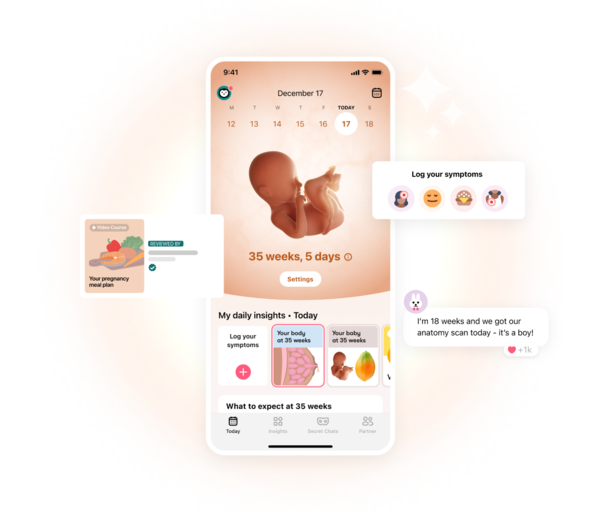Varicose veins that appear on the vulva, or vulvar varicosities, aren’t uncommon among moms-to-be. They don’t always lead to any symptoms and usually disappear on their own about a month after delivery. Here’s everything you need to know about vulvar varicosities, from common causes to effective treatment options.
-
Tracking cycle
-
Getting pregnant
-
Pregnancy
-
Help Center
-
Flo for Partners
-
Anonymous Mode
-
Flo app reviews
-
Flo Premium New
-
Secret Chats New
-
Symptom Checker New
-
Your cycle
-
Health 360°
-
Getting pregnant
-
Pregnancy
-
Being a mom
-
LGBTQ+
-
Quizzes
-
Ovulation calculator
-
hCG calculator
-
Pregnancy test calculator
-
Menstrual cycle calculator
-
Period calculator
-
Implantation calculator
-
Pregnancy weeks to months calculator
-
Pregnancy due date calculator
-
IVF and FET due date calculator
-
Due date calculator by ultrasound
-
Medical Affairs
-
Science & Research
-
Pass It On Project New
-
Privacy Portal
-
Press Center
-
Flo Accuracy
-
Careers
-
Contact Us
Vulvar Varicosities: Everything You Need to Know


Every piece of content at Flo Health adheres to the highest editorial standards for language, style, and medical accuracy. To learn what we do to deliver the best health and lifestyle insights to you, check out our content review principles.
What are vulvar varicosities?
Vulvar varicosities are varicose veins (enlarged, dilated, and twisted veins) that appear on your vulva. They can show up on the labia minora and majora and the skin folds of your vulva.
Many women develop vulvar varicosities during pregnancy, especially during second pregnancies. According to different studies, about 10 to 22 percent of pregnant women develop vulvar varicosities. The number might be even higher, since many women can’t feel or see the enlarged veins and receive no diagnosis. Many others decide not to get medical help.
Symptoms of vulvar varicosities
You may develop vulvar varicosities without knowing about the condition, since you may find it difficult to see your vulva, particularly during pregnancy.
Vulvar varicosities typically appear as soft, purple or blue-colored veins that protrude out from the skin or appear twisted.
Vulvar varicosities can cause the following symptoms:
- Pain or pressure in the vulva
- A feeling of fullness or heaviness in the vulva
- Pain while having sexual intercourse
- Discomfort or pain while walking
- Itchiness
Vulvar varicosities may appear alone or in association with varicose veins in the lower extremities or pelvic region.
Causes of vulvar varicosities
Vulvar varicosities tend to occur most commonly during pregnancy because of increased blood volume in the pelvic region and decreased blood flow from the lower body to the heart. Moreover, the levels of the hormones progesterone and estrogen are constantly changing at this time. This can lead to the walls of your veins becoming more relaxed, causing them to get larger. This can cause your blood to pool in the veins in your lower legs, pelvis, and vulva, resulting in varicosities.
Take a quiz
Find out what you can do with our Health Assistant
Vulvar varicosities tend to occur most commonly during pregnancy because of increased blood volume in the pelvic region and decreased blood flow from the lower body to the heart.
Having varicose veins in the pelvic region also raises your likelihood of developing vulvar varicosities. This can cause pain in your pelvis and the surrounding region (upper thighs and lower back). Aging also makes you more prone to developing varicose veins. As you get older, your veins lose their functional and structural efficiency, leading to decreased blood circulation. Low blood pressure, obesity, and a family history of varicose veins may all increase the risk of developing varicosities.
Ways to diagnose vulvar varicosities
Your physician can diagnose the condition by doing a physical exam. They may ask about your symptoms and examine any swelling. In certain cases, they may do an ultrasound to diagnose vulvar varicosities and assess their severity.
They may consider other tests such as a CT scan, venography, MRI, or laparoscopy if they suspect an underlying condition such as pelvic congestion syndrome. Recent research shows that the “gold standard” test is a transvaginal duplex ultrasound.
Treating vulvar varicosities
Treating vulvar varicosities during pregnancy is all about managing symptoms. You might want to consult a vascular specialist to get recommendations about how to deal with this condition. You can get relief from vulvar varicosities by following these steps:
- Apply cold compresses or ice to the vulvar area.
- Wear a vulvar varicosity support garment. Choose one that is specifically designed to provide relief from vulvar varicosities. It is also important to wear lower-limb compression stockings.
- Change your position regularly, as this helps relieve pressure on your body. You should also avoid sitting or standing for a long time.
- Elevate your legs. This helps promote circulation. You can also prop up your hips while lying down.

If you have more severe symptoms or additional conditions, your physician or vascular specialist may also recommend the following:
- To help with itchiness, take a bath using a foaming solution without soap and apply only a small amount on your vulva. As advised by your doctor, a topical corticosteroid can also help ease itching.
- If you have a blood clot in the vulvar varicosity, they may prescribe medication to prevent further blood clots and break down the existing one.
For women with severe symptoms, the doctor may prescribe more aggressive treatment modalities such as:
- Sclerotherapy — In this procedure, the doctor injects a special sclerosing solution in the varicose veins that causes scarring of the veins and closes them.
- Transcatheter embolization — Embolization is a minimally invasive procedure during which medications or synthetic materials called embolic agents are placed through a catheter into the blood vessel to prevent blood flow to the area.
- Phlebectomy — In this procedure, the doctor removes the vulvar varicosities by making small incisions on the surface of the skin.
How to prevent vulvar varicosities
You may not be able to prevent vulvar varicosities, particularly during pregnancy. However, there are certain things you can do to decrease the overall risk of developing varicose veins. The following help encourage proper blood circulation in the legs:
- Exercise regularly.
- Maintain a healthy weight.
- Eat a healthy diet.
- Keep your legs elevated while sitting.
- Avoid high heels.
- Change your position (for example, from sitting to standing) frequently.
- Wear compression stockings.
- Avoid clothing that is too tight around your groin or waist.
Possible risks and complications
Very rarely, vulvar varicosities may bleed during a vaginal delivery. However, due to the small amount of blood in them, the doctor can easily control the bleeding. They also won’t prevent you from having a vaginal delivery and don’t lead to any major childbirth complications.
When to see a doctor
You should see a doctor immediately if you develop signs and symptoms of a blood clot, such as a very painful, swollen, hard, and red vein.
Vulvar varicosities can be unpleasant. If you get them while pregnant, they can cause discomfort, but you can get some relief with the recommendations above. Vulvar varicosities during pregnancy usually get better within six weeks after delivery. You may need more extensive therapy if you aren’t pregnant and develop them, but several procedures are available to provide you relief.


Hey, I'm Anique
I started using Flo app to track my period and ovulation because we wanted to have a baby.


The Flo app helped me learn about my body and spot ovulation signs during our conception journey.


I vividly
remember the day
that we switched
Flo into
Pregnancy Mode — it was
such a special
moment.
Real stories, real results
Learn how the Flo app became an amazing cheerleader for us on our conception journey.
References
History of updates
Current version (03 October 2019)
Published (03 October 2019)
In this article

Get your personal guide to pregnancy with the Flo app
-
Follow your baby's growth week by week
-
Get expert info on symptoms, safe foods, and more
-
Chat with other parents-to-be




